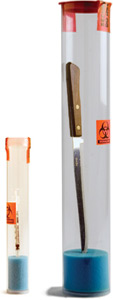- 01: Introduction
- 02: History
- 03: Propellants, Firearms, and Ammunition Development
- 04: Modern Firearms Manufacture
- 05: Small Arms Ammunition
- 06: Evidence Handling Procedures
- Introduction
- Objectives
- AFTE Knowledge and Ability Factors
- Types of Evidence
- Associative Evidence
- The Crime Scene
- Evidence Submission
- Laboratory Evidence Handling
- Case Tracking Within the Laboratory
- Firearm and Toolmark Examination Considerations
- Selected Bibliography
- 07: Equipment and Instrumentation
- 08: Examination of Firearms
- 09: Cartridge and Shotshell Examination
- 10: Characterization and Evaluation of Fired Projectiles
- 11: Bullet Comparison and Identification
- 12: Gunshot Residue and Distance Determination
- 13: Toolmark Identification
- 14: Communicating Results
- Resources


Toolmark Evidence
Home > Evidence Handling Procedures > The Crime Scene > Collection of Evidence > Toolmark Evidence
Investigations involving tools and toolmarks cover a broad spectrum of crime scenes and materials. Therefore, toolmark evidence collection requires various techniques. A tool is defined as any item that is used for mechanical advantage. The actual tool used during the commission of a crime may not be obvious. For example, a butter knife is considered a tool when used to pry open a drawer during a burglary. Toolmarked items are any objects marked by the use of a tool(s).
Tools

Sharps packaging
The operating surfaces of suspect tools should be protected and preserved. The tool should be individually packaged and identified with a string tag bearing the information required by agency crime scene search protocols. If agency protocols mandate the direct marking of evidence, the required information should be scribed in an area away from the operating surface of the tool.
Tool evidence should be sealed in a strong, secure container. If a tool is a sharp, especially a potentially body fluid-contaminated sharp, it should be packaged in a leak proof, puncture-resistant, sealed container. Precautions taken during packaging help to prevent the introduction of contaminated sources of trace material.




